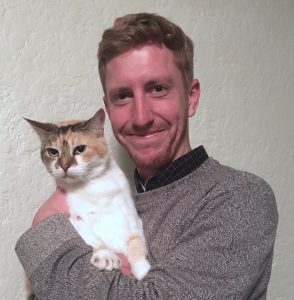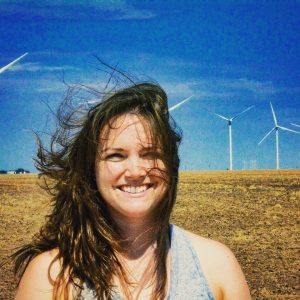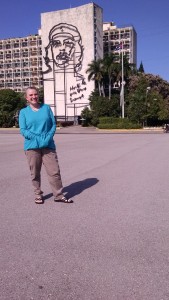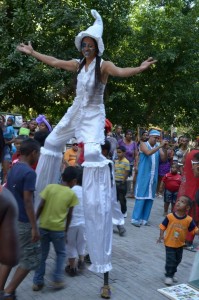Some of the bios of Cuba Participants – J-Term 2017!
 Cody Minnich
Cody Minnich
I was born and raised in Colorado and attended undergrad in Portland, OR where I majored in TESOL. After teaching English to refugees in Portland, I was inspired to pursue a Master’s in Public Administration and ultimately found myself here at MIIS.
 Tara Newell
Tara Newell
Tara Newell is a Peace Corps Masters International Student, who completed her two years as a Peace Corps Volunteer in Cameroon in October. She will graduate with her MPA in May 2017. Tara loves to travel and learn about other cultures and tries to do it as often as possible. Tara has always hoped for an opportunity to visit Cuba and experience life there firsthand, so she is very excited for this trip!
 James Walker
James Walker
I am a Masters candidate for International Policy and development. I’m from Newport, Rhode Island and I’m passionate about learning languages and sustainable development. I speak French and German and recently picked up Spanish here at MIIS this past summer. I interned for Senator Sheldon Whitehouse who is a key advocate of environmentalism in the Senate and who helped establish the Block Island wind farm. I plan to work for a sustainable development company either in the Americas or Europe after my time at MIIS.
 Tammi Ragan
Tammi Ragan
Hi, all! My name is Tammi Ragan and I a third semester Public Administration student studying Spanish. I grew up in Okinawa, Japan and that’s where I consider home. One of the reasons I came to MIIS, was because of the Cuba trip that was offered. So I am stoked for this opportunity, and hope I can find time for a diving trip while there. I am interested in sustainable development and how the environment plays into the future of developing nations.
 Ash Gauer
Ash Gauer
Growing up in one of the most multicultural and geographically isolated places on earth, Ashley realized the importance & value of community early on. She spent her undergraduate years exploring identity, social justice, community development, & leadership as a Martín Baró Scholar in the heart of San Francisco. She received her BA in Bio-Psychology and minored in Public Service & Philosophy. She has studied & volunteered across three continents and has helped launch two social enterprises in Cambodia that support a community school. She has worked in education, health, & community development for 10+ years. She is a Joint Master’s Degree Candidate in International Education Management and Public Administration with an emphasis in Social Entrepreneurship. An ongoing student of Earthship Biotecture, she’s an advocate for radically sustainable buildings, and will one day build an Earthship-style café/retail/ed hub.
 Jessica Anderson
Jessica Anderson
Jessica’s imperative is to work with industries to make improvements in sustainability practices.
Jessica has worked in a Fortune 500 company for four years in a Quality Assurance role at Pepperidge Farm. She has cross-functional leadership experience and the capability to work out compromises in tough circumstances without sacrificing product integrity. She intends to use this knowledge in working with companies to improve their efficiencies and their social and environmental missions.
Jessica holds a B.S. in Environmental Science from the University of Connecticut. In the winter you can find her carving sweet arcs into the pow-pow of a ski mountain, and in the summer she is slicing her serve on the tennis court. She can also be found kicking a soccer ball or two on the pitch with her buddies at MIIS. A bit of a Jack, or Jill, or all trades, she is extremely adaptable to any situation and strives for excellence in all that she touches.
 Andrew Meador
Andrew Meador
I come from the northern suburbs of Chicago. I attended Williams College where I initially focused on pre-med studies and biology but switched to the humanities and language. After graduation I entered the Army and joined the Special Forces as a medic, deploying to Afghanistan and other locations and spending three of my seven years based in Okinawa, Japan. I have attended the Middlebury Language Schools twice, once each for Japanese and Chinese, and I am currently a second-semester candidate for MANPTS here at MIIS.
 Alie Jones
Alie Jones
Alie Jones (Alexandria) is a 25 years old filmmaker, music enthusiast, and social change agent from Fresno, CA. She is currently pursuing a Masters of Arts in Public Administration at the Middlebury Institute of International Studies. Before MIIS she attended CSU Monterey Bay. She spent her final year of undergraduate career in the south of France in Aix-en-Provence. In May 2014, she graduated with a B.A. in Cinematic Arts and Technology from CSU Monterey Bay and a minor in Creative Writing and Social Action. Being involved with sustainability changed the way she viewed activism. Her experience acting in social action pieces like the Vagina Monologues and the Laramie Project changed her perception of herself. She is passionate about promoting women’s empowerment, body positivity, and engaging in new conversations through the arts.





